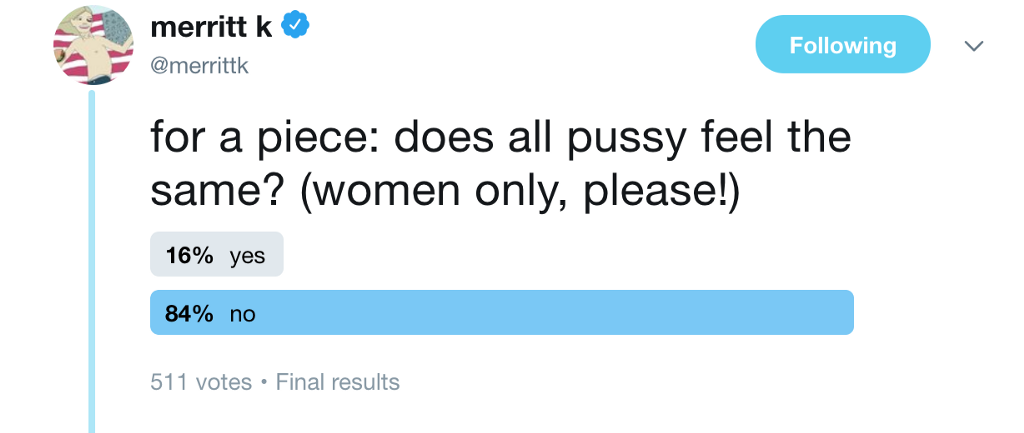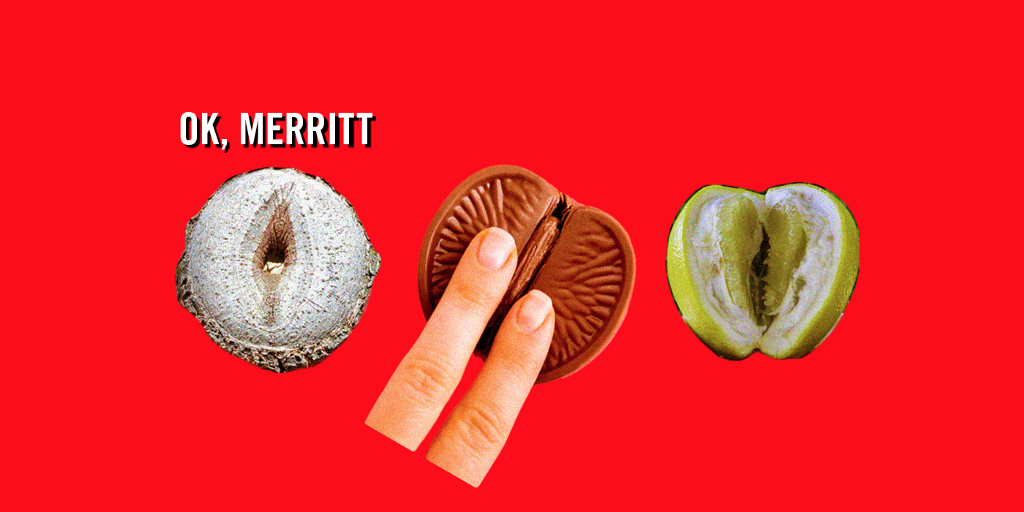Men may be from Mars and women from Venus, but when it comes to one issue in particular, it seems like we’ve reached an historic interplanetary accord.
That issue? For lack of a suitable euphemism, how pussy feels. In my latest Twitter poll, 84 percent of both men and women insist that all vaginas feel different — or at least that not all pussy feels the same.


I have to admit, I’m surprised—I’d never have anticipated the numbers to be the same between men and women. If anything, I’d have expected more women to say that all pussy feels the same. I mean, how would most (straight) women know one way or the other? Also, 16 percent feels like a high percentage of guys to say that they can’t tell a difference. What’s that all about? And more to the point, is the majority right?
After all, the only thing this poll gets at is beliefs. And people believe a lot of things: That the Earth is flat, that Coldplay is a good band, that smooth peanut butter is better than crunchy. You can’t trust people, is what I’m saying.
What can you trust?
Cold, hard science, baby.
A 2005 study of female genital dimensions with the incredible title “Female Genital Appearance: ‘Normality’ Unfolds” looked at 50 premenopausal women having gynecological procedures in an attempt to address a dearth of accurate representations of vulvas and vaginas. It’s fascinating reading, but I’ll summarize a few findings that are most relevant to the discussion at hand.
First, the mean vaginal length was 9.6 centimeters—though it should be noted that this measurement was taken while the women were under anesthesia, so it doesn’t account for a phenomenon called “vaginal tenting” that I’ll get back to later. Second, vaginal length ranged from 6.5 centimeters all the way to 12.5 centimeters, demonstrating considerable variation — as did every variable considered by the study (e.g., clitoral size; labial length and width; color and roughness; vaginal length; distance from clitoris to urethral orifice; and distance from posterior fourchette to anterior anal margin). Finally, the researchers found no relationship between any of the different genital measurements and factors like age, ethnicity, sexual history or even having given birth.
So if you believed that vaginal variation was caused by too many dicks or babies, you can go ahead and throw that old sexist chestnut out the window. I mean, that’s not how muscles work! This conception that women can get “loose” has no basis in scientific fact. And besides, the phrase “loose woman”? It refers to loose — as opposed to resolute — morals. The myth of virginal tightness is obviously reflective of the belief that sex “ruins” women and a historical warning to women not to sleep around lest they screw themselves (sorry) out of being marriage material.
I’d like to present some supporting anecdotal evidence here in my experience as a gay woman. Obviously I’ve got a limited perspective, because as much as queer women might like to be able to feel our strap-ons, science still refuses to make it happen. (Probably on account of homophobia.) But there’s substantial variation in how it feels to have your hand inside someone. Some vaginas are extremely tight, while others are more immediately accommodating. That said, tightness and depth is heavily context-dependent. Vaginal tenting — which I’d be surprised to hear named in any American sex-ed class — involves the contraction of the cervix and subsequent expansion of the vagina during arousal.
In other words, just like a dick, the shape of a pussy corresponds to horniness.
That means there’s not only between-women variation, but within-woman variation, too. Still, there are some striking points of similarity. Like the study above noted, I’ve never found the vaginas of older women or those of women who have given birth to be noticeably different. And despite what some would have you believe, I’ve also never noticed a significant difference between natal and surgically-constructed vaginas. With the exception being that the latter don’t tent in the same way as the former, they feel pretty much the same to the touch. (And hey, you can get a fist inside both, if you’re committed.)
How then, do our survey results line up with the facts? Well, I agree with them, for one thing. But more importantly, the science seems to suggest that 84 percent of us are on the money. While there don’t seem to be any scientific studies explicitly asking people to compare how the pussies they’ve experienced feel, the research we do have says that vaginas vary widely.
Just like vulvas, all vaginas are different.
And just to restate this, Those differences aren’t caused by having sex or babies. Again, that’s not how muscles work. We’re talking about a natural distribution of variation of the same kind demonstrated in every other aspect of human anatomy, from height to penis length to eyebrow lushness.
Lastly, what do we make of the other 16 percent of people I polled? My friend Liz offers up one possibility:


